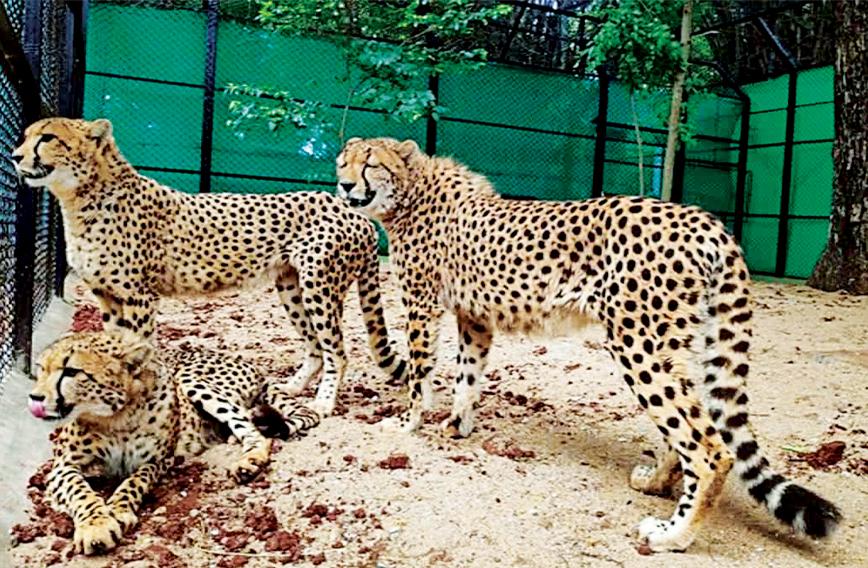
Cheetahs in an enclosure while in captivity at Kuno
Making a tally of cheetahs, dead and alive
Civil Society News, New Delhi
Deaths of cheetahs in rapid succession at Kuno National Park in Madhya Pradesh suggest that the project for introducing the cats from Namibia and South Africa is running aground.
Five adult cheetahs and three cubs born in Kuno have so far died, practically one after the other. Four of the adults died in captivity and one was in the wild. Of the 20 cheetahs that arrived, 12 have been released into the wild after periods in captivity. Now four adult cheetahs remain in captivity and of them two or maybe three are believed to be unfit for the wild.
The project has been shrouded in secrecy after it was widely criticized by wildlife experts for being fanciful since India lacks the habitat for cheetahs. Any news that comes out of Kuno is in dribs and drabs.
The death of the fifth adult was at first attributed by technical experts involved with the project to a radio collar that the cheetah was wearing causing abrasion and leading to a fatal infection because of the rains as well as the hot and humid weather at Kuno. But shortly afterwards the government said the death was from natural causes and had nothing to do with the collar.
Many experts have questioned the viability of the cheetah project from the outset, saying that India has many other pressing wildlife concerns to be addressed. Moreover, Kuno was to be used for translocating the lions from Gir, a project which seems to have been shelved in spite of a standing order by the Supreme Court.
Now, with these deaths, the cheetah project management has come in for criticism for lacking purpose and planning. It is inexcusable that four cheetahs should have died while in captivity and monitored by CCTV cameras.
The fifth death in the wild is different. But if the purpose of the project is to have a free-ranging population of cheetahs in the wild it is not being served by obsessively monitoring them. Radio collars are used on animals for research purposes. But in Kuno, in addition to the collars, to track each cat there is a team of four and a vehicle doing 12-hour shifts 24x7.
Releasing cheetahs into the wild means allowing the cats to discover their new habitat, hunt, mate and carve out personal territory. But excessive monitoring and repeated intervention to “save” cheetahs is not allowing them to adapt to their surroundings.
The officially stated purpose of the project is to establish a free-ranging population of wild cheetahs to bring back a species that has gone extinct in India, to help save grasslands and other open natural ecosystems and then save critically endangered species like the great Indian bustard. The question now is whether these objectives are being achieved. Or if it has been turned into a project for captive breeding of cheetahs.
The action plan of the project says up to 50 percent of the cheetahs could die in the first year as they settle into their new habitat. The latest death in the wild could be accounted for in this fashion. But four other deaths have occurred in captivity, indicating inadequate management at Kuno.
When the cheetahs arrived, they were kept in quarantine in spaces that were 10m x 10m because animals in quarantine need to be confined to small spaces. Next, they were released into the hunting bomas which is a series of 10 or 11 enclosures, each of which on an average would be 600 sq m in size. Taken together, these enclosures would be about 6 sq km. All the enclosures are interconnected with gates so that the cheetahs can move between enclosures when required. But in total there was just 6 sq km available to them. Before they began being released into the wild, there were 20 adult cheetahs in this space.
 “At one level, the deaths are very surprising because four of the deaths have happened in captivity. I and many of us thought the big challenge would be once the cheetahs were released. Because then they’re on their own. They have to navigate a new landscape. Other predators, human beings, livestock, dogs, roads, open wells, you know — all of what India is about in the rural hinterland,” says Ravi Chellam, wildlife biologist, CEO of the Metastring Foundation and Coordinator, Biodiversity Collaborative.
“At one level, the deaths are very surprising because four of the deaths have happened in captivity. I and many of us thought the big challenge would be once the cheetahs were released. Because then they’re on their own. They have to navigate a new landscape. Other predators, human beings, livestock, dogs, roads, open wells, you know — all of what India is about in the rural hinterland,” says Ravi Chellam, wildlife biologist, CEO of the Metastring Foundation and Coordinator, Biodiversity Collaborative.
“The two things to note are that four of the deaths have been in captivity, not in a free-ranging situation, except for the most recent. And secondly, the period of captivity has been much longer than mentioned in the action plan,” says Chellam.
“If you look at the action plan, they talk of one-month quarantine, which is an international standard. And four to maximum eight weeks in what they call the acclimatization enclosure or hunting boma. The quarantine enclosure is really small. The first lot from Namibia came on September 17, 2022. Until mid-third week of March 2023, if I remember correctly, no cheetah had been released into the wild,” explains Chellam.
“Even taking the upper limit of two months for acclimatization and one month in quarantine, by mid-December they should have been released. But the first cheetahs were released only in mid-March. And there have been subsequent releases in April, May, June and even in July,” says Chellam.
“Of course, some of this involves cheetahs from South Africa, who came in mid-February. So, many of the South African cheetahs seem to have been released faster than the Namibian cheetahs,” he adds.
On acclimatization, Chellam explains: “Four to six weeks is ideal. The action plan talks of up to eight weeks, beyond that was completely unjustified.The first Namibian cheetah was released in mid-March, which means 90 days or 12 weeks behind schedule.”
“So, the first four adult cheetahs dying reflects, for me, lack of preparation, insufficient human resources, maybe even skills and competencies lacking. And poor planning and decision-making and a glaring lack of transparency and accountability.”
Regarding interventions in the wild, Chellam says: “There is this great obsession with not allowing an animal to die. I keep repeating births and deaths are quite normal. What we need to guard against and look out for are the circumstances of the death and the cause of the death. They seem to have gotten into a frame of mind where they think animals in captivity are secure. The animals, once released, will face a whole lot of risks and threats, and that’s what we need to focus on.
“Pavan, I think, is the name of the male cheetah who’s been caught multiple times. Aasha is the female who has also been caught multiple times. So, in some sense, a potential situation where the animal could have got into conflict and could have died as a result has been averted by human intervention.
“There’s also another case where two pairs of males, that is, four cheetahs, got into a tussle. And one pair got the better of the other, quite badly injuring one of them. Again, the management intervened and captured the pair with the injured male so that he could be treated. If the interaction had been allowed to proceed without any intervention, we might have lost a cheetah in a free-ranging situation but this is natural. Males will fight. They’re trying to establish their territory and so on.”
THE DEATHS
The deaths of four adult cheetahs who died in captivity point to poor project management. The reason given for Sasha’s death was that she had a pre-existing kidney problem. The question arises: why did India accept an animal with a disease? Also, how ethical was it to fly the ailing animal in a box across climatic zones and then place her in a completely unfamiliar habitat? Sasha had to transition from the southern hemisphere to the northern hemisphere. Did the Namibian authorities mislead India or was her condition not known at the time?
The second cheetah who died, Uday, was found moving around in a disoriented manner. But this does not explain the cause of the death. Could it be that he banged his head into a fence at one of the enclosures?
“There is still insufficient clarity, but at least it is in the public domain. A little detail that has caught the attention of people is the mention of cerebral haemorrhage. In South Africa there have been cases when cheetahs have accidentally, at high speed, banged against the fence of an enclosure. And as a result, suffered cerebral haemorrhage. So that could be a possibility, but we don’t know,” says Chellam.
The third death was of a female, Daksha. Two males were introduced to her in an attempt to get her to mate. As it transpired, she was not ready to mate. In the wild, she could have escaped the harrying males. But in the confines of the boma, she had to fight back, got injured and died.
The post-mortem of the fourth cheetah who died has revealed that the male was underweight and had pre-existing health conditions. Why would a cheetah in captivity be underweight is the question.
Chellam points to poor management on the ground and lack of purpose. “Is this project about captive breeding of cheetahs, or is it about establishing a free-ranging population of wild cheetahs? Clearly, captive breeding cannot become a priority,” he says.
Comments
-

Amit Kumar Bose - Aug. 30, 2023, 3:12 p.m.
I'd go even further in the last line by asking : Is the Kuno project about reintroducing the cheetah to India or a cheetah safari park with an endless supply coming from BRICS founder friend South Africa?
-

Salone - Aug. 3, 2023, 12:45 p.m.
As we read this article, the 6th cheetah has died. But I guess we will wait till 10 are dead...as 50% is an accepted failure. Which brings me to the point that you have pointed out in the article..why do this project at all? Seems no different from the maharajas of yore
-

Kannan Vaithianathan - July 26, 2023, 3:29 p.m.
Project Cheetah is the "Vanity" project. On the other hand, why do not we think of a small population of Gir Lions to be translocated to Kuno? In African countries they co-exist?
-

G shaheed - July 22, 2023, 8:55 p.m.
Forceful article
-

Rosemary Viswanath - July 22, 2023, 8:51 a.m.
good piece Ravi - it is a case study on how an unquestionable worship and salute to the wishes of the top guy leave everything in disarray - every part of this story of misplaced priorites and pandering to ego and hubris hubris filled makes one wince in agony




